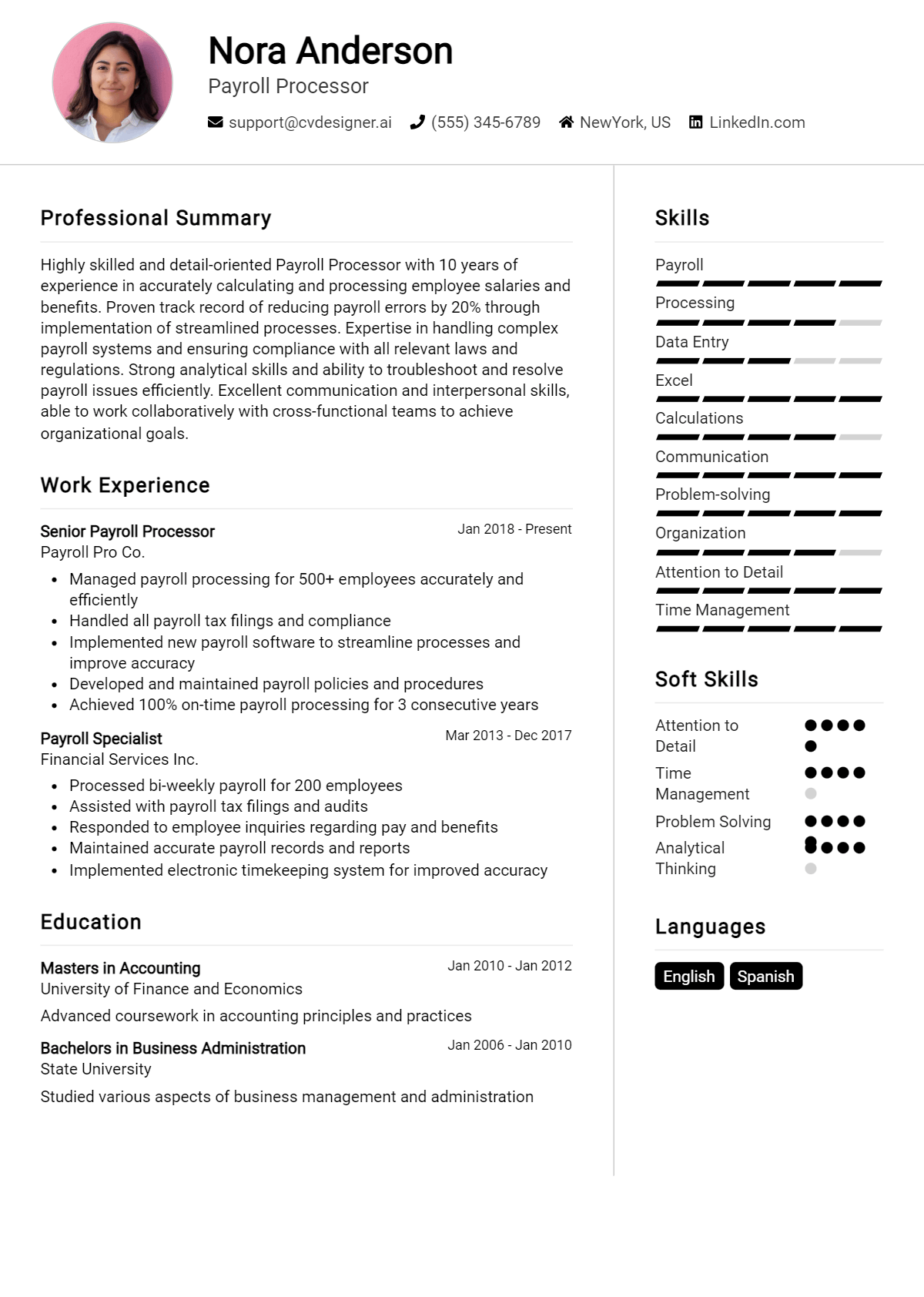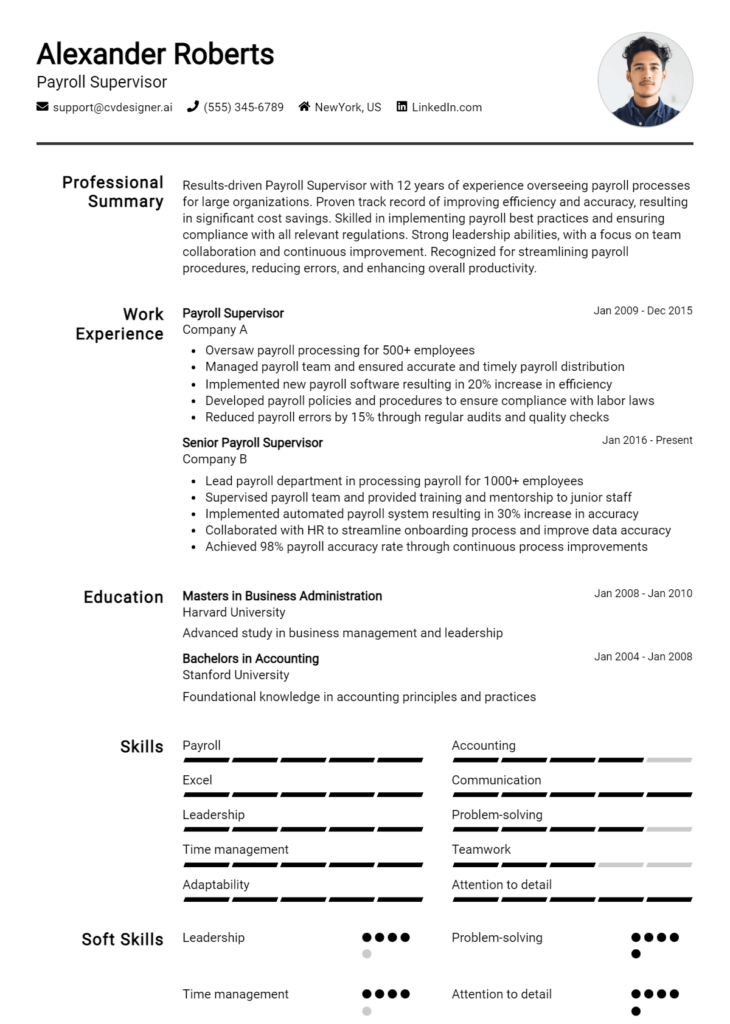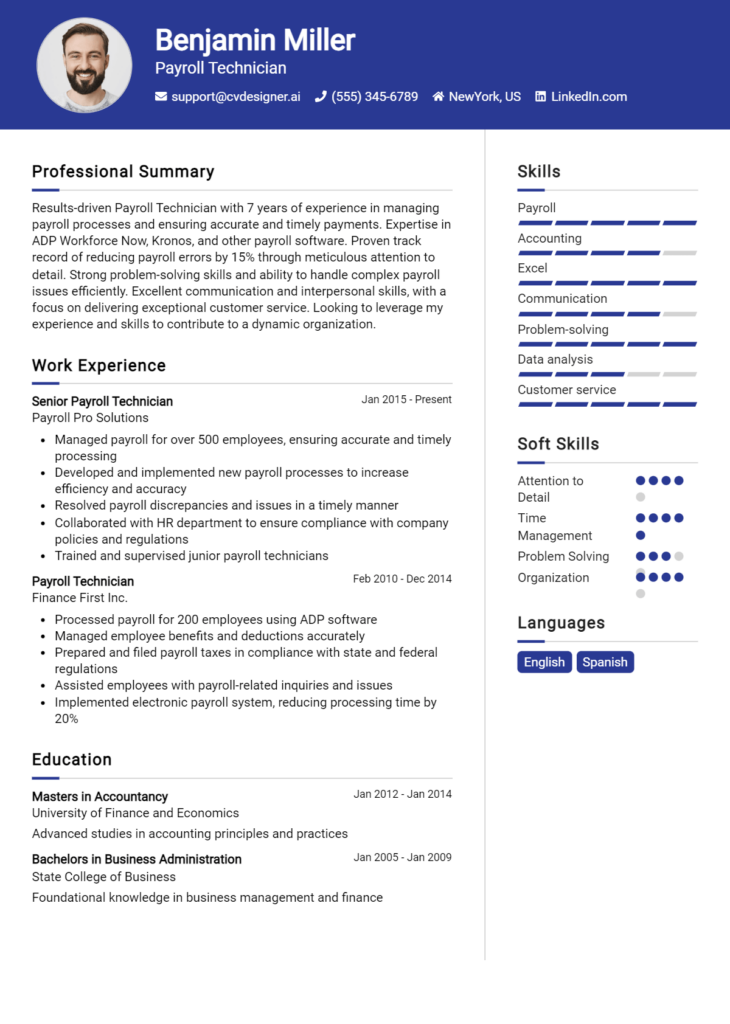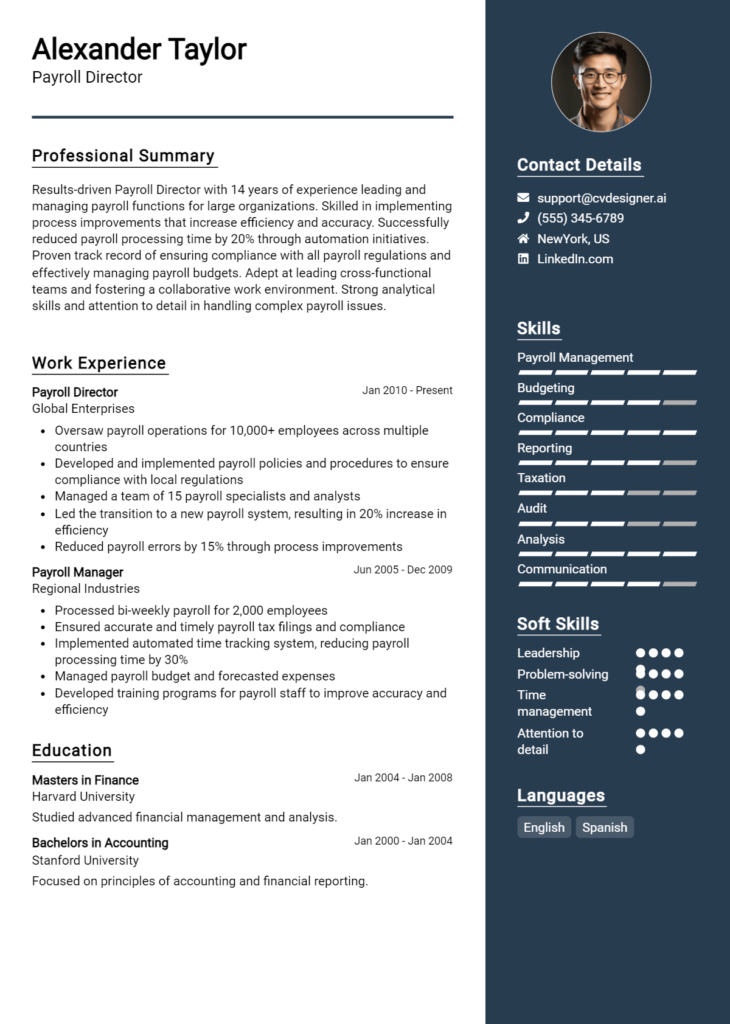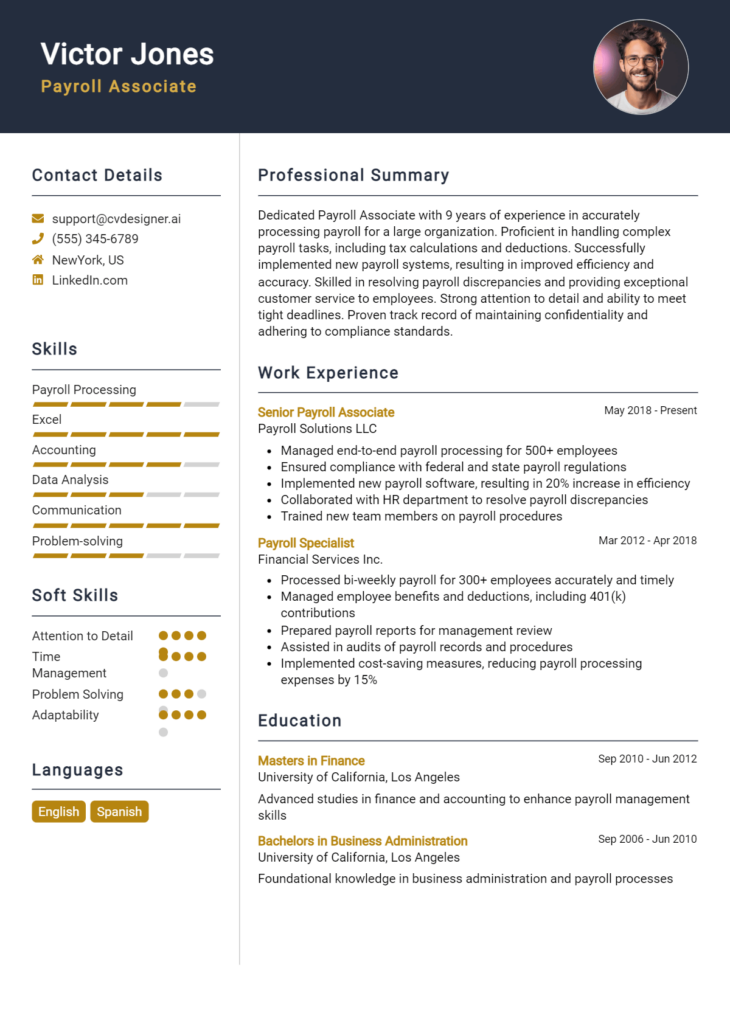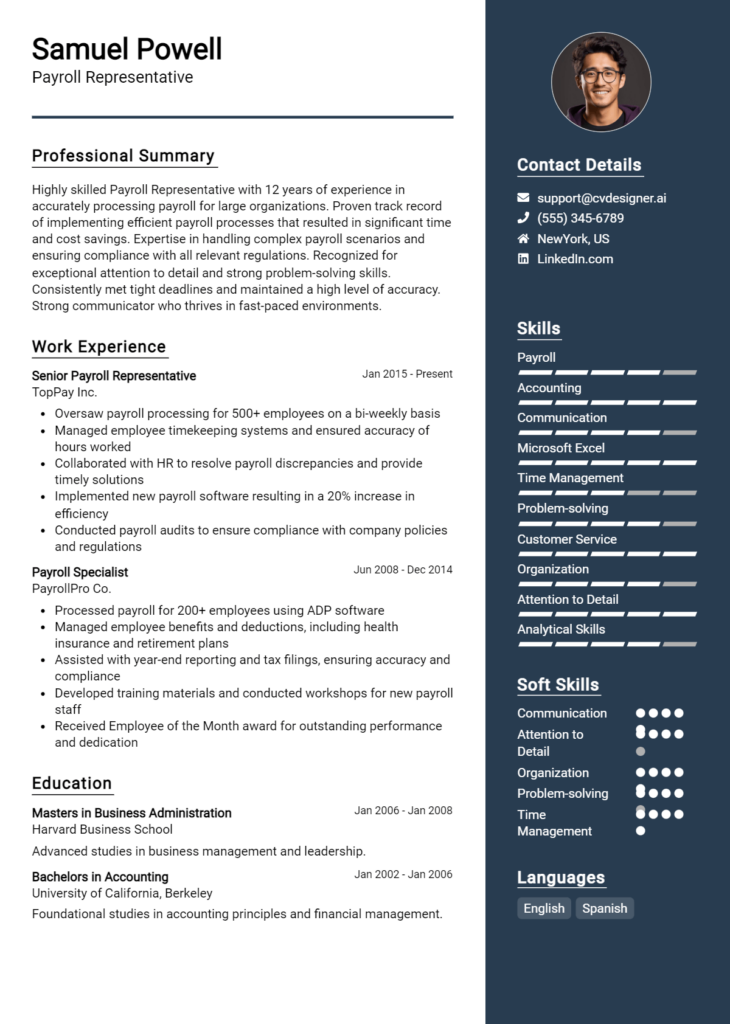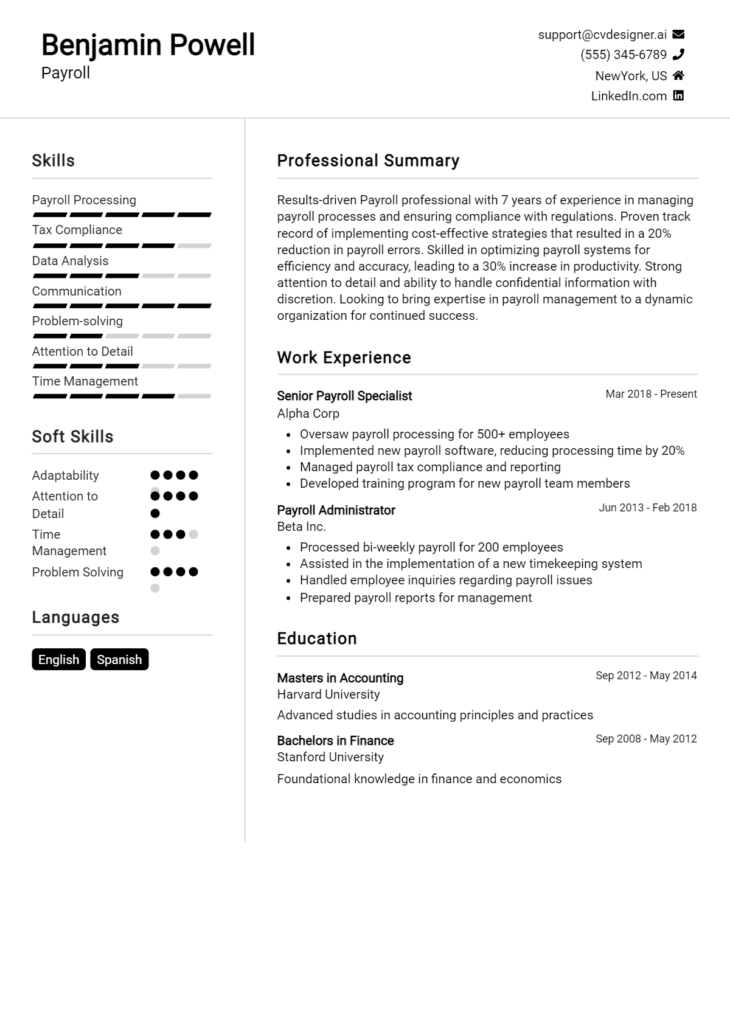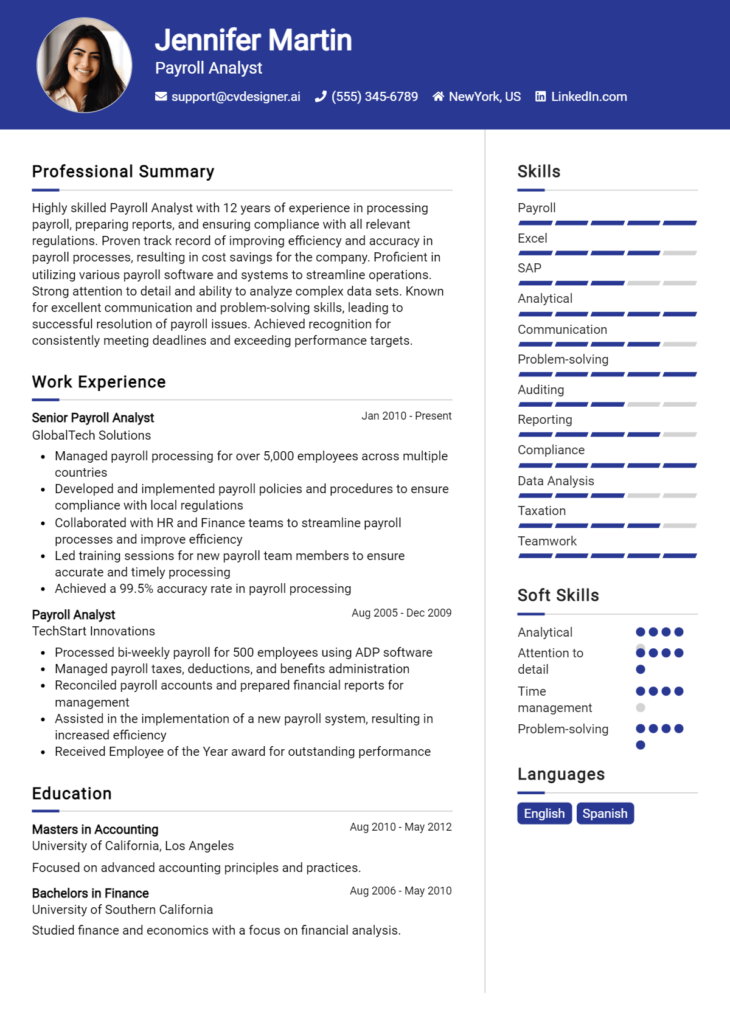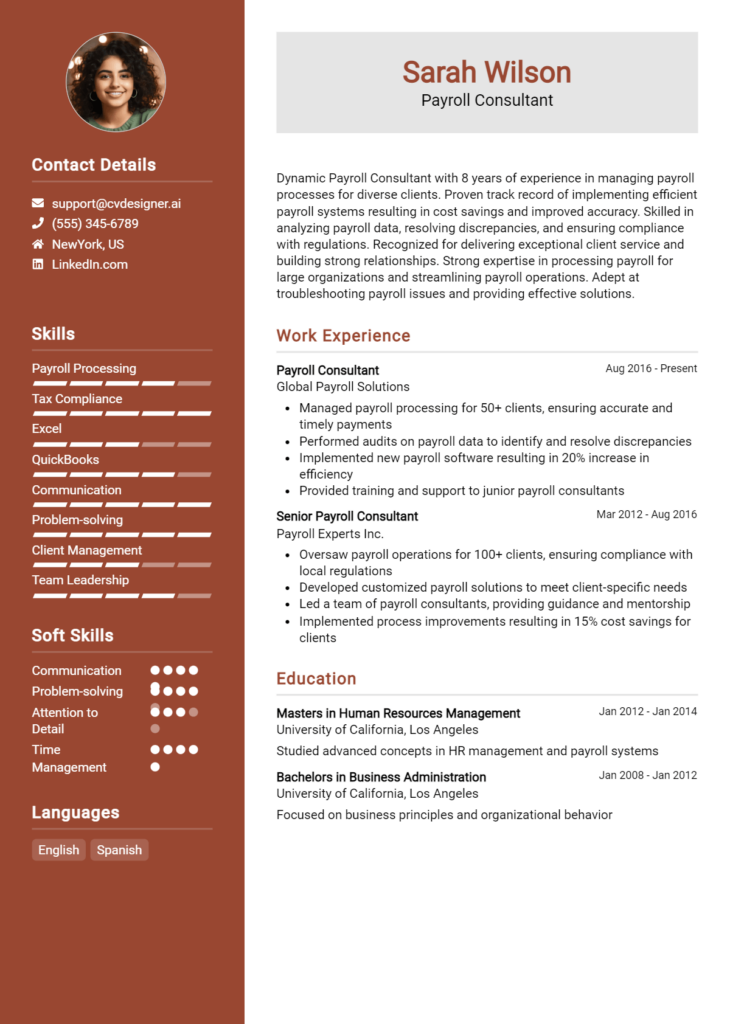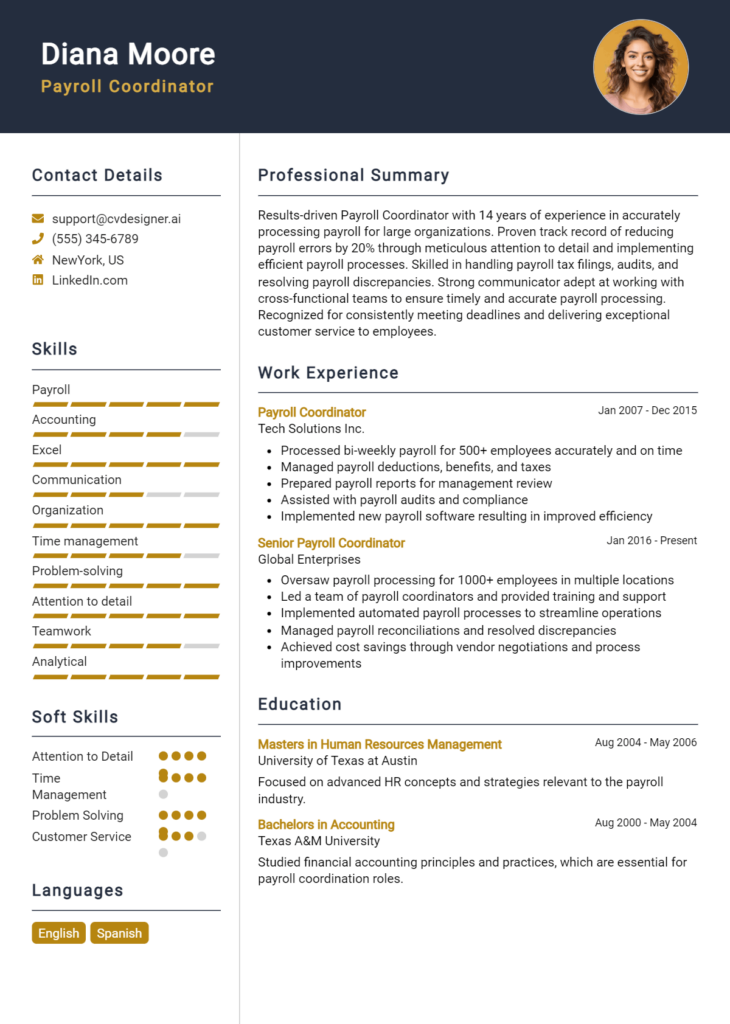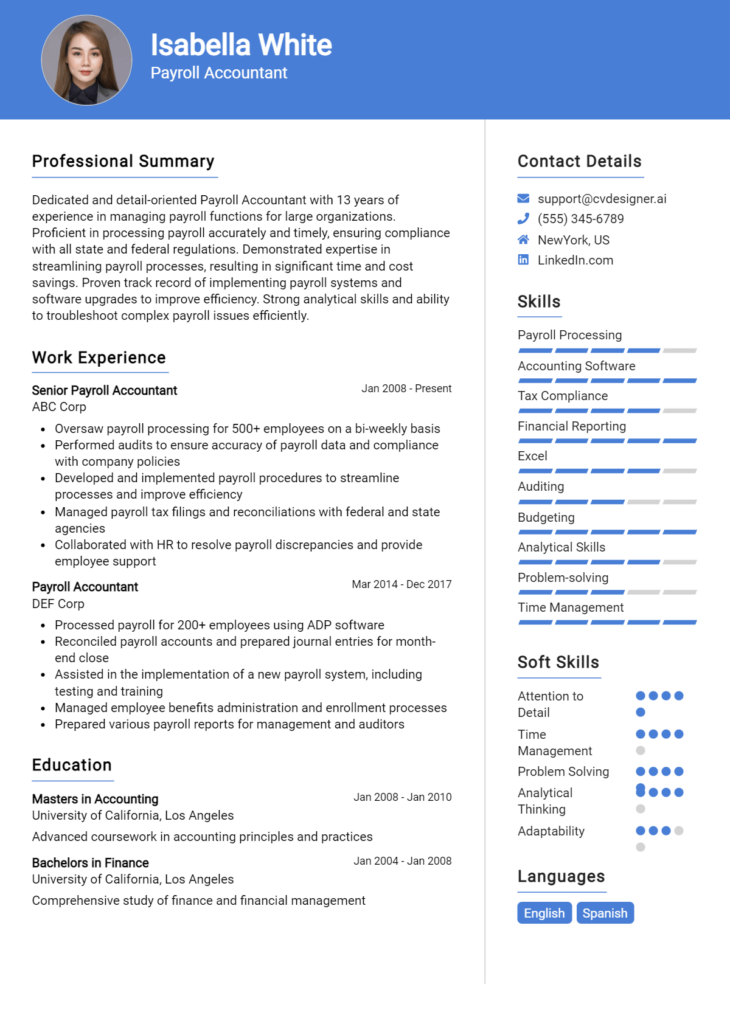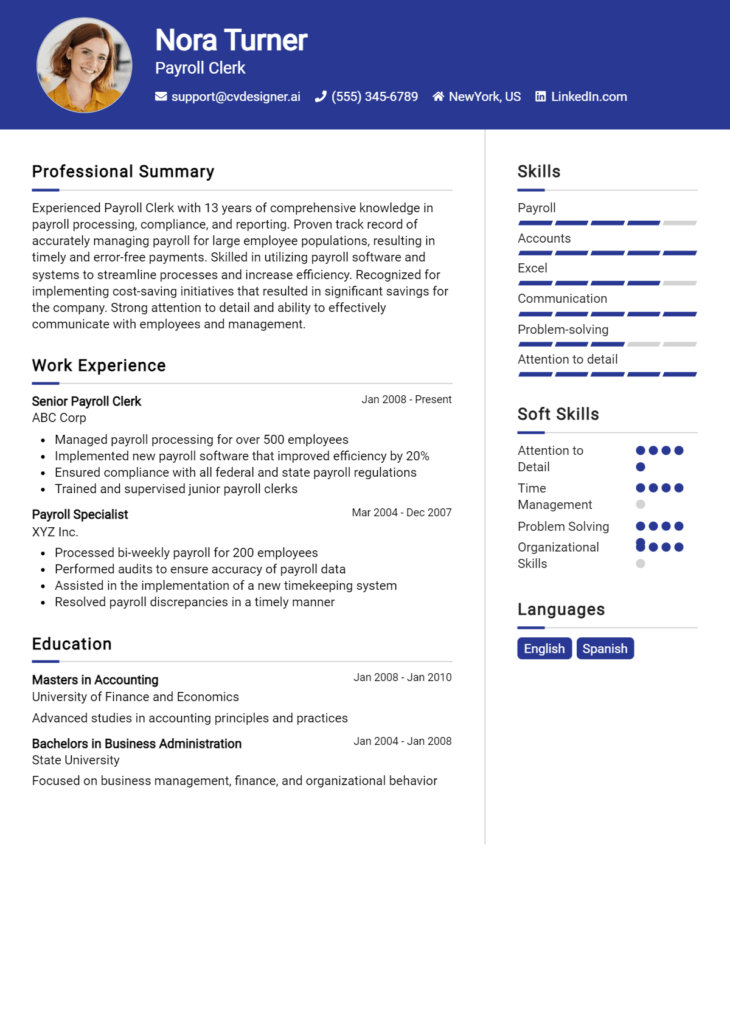Most Popular Payroll Processor Resume Examples
Explore additional Payroll Processor resume samples and guides and see what works for your level of experience or role.
As a Payroll Processor, you play a crucial role in ensuring that employees are compensated accurately and on time, making you an integral part of any organization. Your responsibilities not only include calculating wages and managing payroll records but also ensuring compliance with various laws and regulations. Given the importance of your role, having a well-crafted resume is essential to stand out in a competitive job market. A strong resume highlights your skills and experiences, showcasing your ability to handle sensitive information, utilize payroll software, and maintain meticulous records.
In this comprehensive Payroll Processor resume writing guide, we will explore the key aspects of crafting an effective resume tailored for this field. We will delve into the specific responsibilities and skills that employers are looking for, discuss the best formats to use for maximum impact, and identify common mistakes that can hinder your chances of landing an interview. Additionally, we will provide resume examples for various experience levels, along with tips on how to write an engaging resume that reflects your unique qualifications. Finally, you'll find guidance on selecting the right resume templates to elevate your application. Whether you're just starting out or looking to advance your career, this guide will equip you with the knowledge and tools needed to create a standout resume.
Key Responsibilities and Skills for a Payroll Processor
A Payroll Processor plays a crucial role in managing employee compensation, ensuring timely and accurate payroll processing, and maintaining compliance with relevant laws and regulations. The key responsibilities of a Payroll Processor typically include:
- Collecting and verifying employee time and attendance records.
- Processing payroll on a regular schedule, including calculating wages, overtime, and deductions.
- Ensuring compliance with federal, state, and local payroll regulations.
- Responding to employee inquiries regarding payroll discrepancies and adjustments.
- Preparing and submitting payroll tax filings and reports.
- Maintaining accurate payroll records and documentation.
- Collaborating with HR and finance departments to streamline payroll processes.
Essential skills required for a Payroll Processor position include:
- Attention to Detail: Ability to accurately process payroll data and identify discrepancies.
- Analytical Skills: Strong problem-solving skills to resolve payroll issues efficiently.
- Knowledge of Payroll Software: Familiarity with payroll systems and software (e.g., ADP, Paychex).
- Mathematical Proficiency: Competence in basic math for calculating wages and deductions.
- Regulatory Knowledge: Understanding of labor laws, tax regulations, and compliance requirements.
- Communication Skills: Strong verbal and written communication to interact with employees and management.
- Time Management: Ability to prioritize tasks and meet payroll deadlines effectively.
Highlighting these skills effectively in the resume skills section is essential, as it allows potential employers to quickly identify your qualifications for the Payroll Processor role. Tailoring these responsibilities and skills to the specific job description will demonstrate your suitability for the position and align your experience with employer expectations.
Additionally, consider how these skills could be relevant in creating a strong CV. By showcasing relevant skills and experiences in your CV, you can present a compelling case for your candidacy, highlighting your ability to contribute positively to the organization's payroll processes.
Best Resume Format and Structure for a Payroll Processor
When crafting a resume for a Payroll Processor position, choosing the right format and structure is vital for showcasing your qualifications effectively. Below is a detailed guide on how to format your resume, including essential sections and tips on what to include.
Contact Information
- Name: Your full name should be at the top, bolded for emphasis.
- Phone Number: A reliable phone number where you can be reached.
- Email Address: Use a professional email address.
- LinkedIn Profile: Include a link to your LinkedIn profile if it is up-to-date and relevant.
- Address: Optional; can include city and state, but full address is not necessary for privacy.
Professional Summary
- This section should be a brief paragraph (2-4 sentences) summarizing your experience, skills, and what you bring to the role. Highlight your expertise in payroll processing, knowledge of payroll software, understanding of taxation laws, and any special accomplishments in your previous roles.
Work Experience
- Job Title, Company Name, Location (Month/Year - Month/Year): List your most recent job first and work backward.
- Bullet Points: Use bullet points to describe your responsibilities and achievements. Focus on quantifiable achievements (e.g., "Processed payroll for over 200 employees, ensuring 100% accuracy," or "Reduced payroll processing time by 20% through improved systems.") Always start with strong action verbs.
- Relevance: Tailor your work experience to highlight roles that directly relate to payroll processing, showcasing relevant tasks such as managing payroll software, handling employee queries, and ensuring compliance with labor laws.
Education
- Degree, Major, School Name, Graduation Year: List your most recent education first. If you have a degree in finance, accounting, human resources, or a related field, highlight it here.
- Relevant Coursework or Projects: If applicable, mention specific courses or projects that are relevant to payroll processing.
Skills
- Technical Skills: Include payroll software you are proficient in (e.g., ADP, Paychex, QuickBooks).
- Soft Skills: Highlight interpersonal skills such as attention to detail, communication, and organizational skills.
- Compliance Knowledge: Mention familiarity with federal and state labor laws, regulations, and tax codes.
Certifications
- List any relevant certifications, such as Certified Payroll Professional (CPP) or Fundamental Payroll Certification (FPC). This section adds credibility to your expertise in payroll processing.
Additional Sections (Optional)
- Professional Affiliations: If you are a member of any payroll or HR-related organizations, include them.
- Volunteer Experience: If relevant, this can showcase additional skills and commitment.
Resume Format Tips
- Choose a Clean Layout: A chronological or combination resume format works well, as it highlights work experience and skills. Ensure that your resume is simple, with clear headings and plenty of white space for readability.
- Consistency: Maintain consistent formatting for fonts, sizes, and bullet points throughout the document.
- Tailor for ATS: Use keywords from the job description to help your resume pass through Applicant Tracking Systems (ATS).
Complementing Cover Letter Format The format of your resume can complement your cover letter by maintaining a consistent style. Use the same font and color scheme in both documents. The cover letter should introduce you and explain why you are a good fit for the Payroll Processor role, referencing specific skills and experiences from your resume. Structure your cover letter with a professional greeting, an engaging opening paragraph, a body that details your qualifications, and a strong closing statement that encourages follow-up.
By following this guide, you can create a polished and effective resume that showcases your qualifications for a Payroll Processor position, while also ensuring that your cover letter aligns seamlessly with your application materials.
Writing Tips and Best Practices for a Payroll Processor Resume
When crafting a resume for a Payroll Processor position, it's essential to focus on clarity, accuracy, and relevance. Highlight your experience with payroll systems, compliance with labor laws, and any software proficiency. Use a clean, professional format that allows hiring managers to quickly identify your qualifications. Incorporate industry-specific keywords to pass through applicant tracking systems, and ensure your accomplishments are quantifiable to demonstrate your impact effectively. Remember to leverage resume writing tips to achieve a polished look, and consider how these practices can also enhance your cover letter.
- Use action verbs like "processed," "managed," and "calculated" to convey your responsibilities effectively.
- Quantify achievements by including metrics, such as the number of employees managed or the percentage of payroll accuracy.
- Incorporate industry-specific keywords such as "FLSA compliance," "tax regulations," and "payroll software" to align with job descriptions.
- Tailor your resume for each job application by emphasizing relevant experience and skills that match the job requirements.
- Highlight additional skills such as attention to detail, analytical skills, and proficiency in spreadsheet software.
- Include any certifications or training related to payroll processing, such as CPP (Certified Payroll Professional).
- Ensure consistency in formatting, font style, and bullet points to maintain a professional appearance throughout the document.
- Keep your resume to one page if you have less than 10 years of experience, focusing on the most pertinent information to the role.
Common Mistakes to Avoid in a Payroll Processor Resume
When crafting a resume for a Payroll Processor position, job seekers often make several common mistakes that can undermine their chances of landing an interview. A well-structured resume should highlight relevant skills and experiences, but many candidates inadvertently dilute their message. To ensure your application stands out, it's essential to avoid these pitfalls:
- Overloading the resume with excessive information that distracts from key qualifications.
- Using generic descriptions that fail to convey specific accomplishments or skills related to payroll processing.
- Neglecting to tailor the resume to the job description, missing out on important keywords and phrases.
- Failing to quantify achievements, such as highlighting the number of employees processed or any cost-saving measures implemented.
- Ignoring formatting consistency, which can make the resume look unprofessional.
- Including irrelevant work experience that does not pertain to payroll processing.
- Using passive language instead of action verbs that convey a sense of initiative and achievement.
- Overlooking spelling and grammatical errors, which can create a negative impression.
- Not including relevant certifications or training that enhance credibility in payroll processing.
To further enhance your resume and avoid these common mistakes, consider reviewing the common mistakes to avoid in a resume for additional insights. Additionally, ensure your cover letter is equally polished by steering clear of common cover letter mistakes that could undermine your overall application.
Sample Payroll Processor Resumes
As the backbone of any organization, Payroll Processors play a crucial role in ensuring that employees are paid accurately and on time. Whether you're an experienced professional or just starting your career, having a well-structured resume can significantly enhance your chances of landing your desired job. Below are three sample resumes tailored for different levels of experience in the Payroll Processor role.
Sample Resume: Experienced Payroll Processor
Jane Doe
[City, State]
[jane.doe@email.com]
[(123) 456-7890]
Summary
Detail-oriented Payroll Processor with over 7 years of experience in payroll management and compliance. Proven track record of managing payroll for over 500 employees, ensuring accuracy and adherence to legal regulations. Strong analytical skills and proficiency in payroll software to streamline processes.
Experience
Senior Payroll Processor
ABC Corporation, [City, State]
June 2018 - Present
- Managed bi-weekly payroll for 500+ employees, ensuring accurate calculations, deductions, and compliance with federal and state regulations.
- Implemented payroll software that reduced processing time by 30% and improved accuracy.
- Trained and supervised junior payroll staff, fostering a collaborative work environment.
- Conducted regular audits to identify and resolve discrepancies in payroll records.
Payroll Processor
XYZ Inc., [City, State]
March 2015 - May 2018
- Processed payroll for 200 employees, maintaining employee records and managing timekeeping systems.
- Assisted in year-end reporting and tax filings, ensuring compliance with IRS regulations.
- Collaborated with HR to address employee inquiries regarding payroll and benefits.
Education
Bachelor of Science in Business Administration
University of [State], [City, State]
Graduated May 2014
Skills
- Payroll Software (ADP, Paychex)
- Microsoft Excel
- Data Analysis
- Compliance and Regulations
- Team Leadership
Sample Resume: Entry-Level Payroll Processor
John Smith
[City, State]
[john.smith@email.com]
[(321) 654-0987]
Objective
Motivated and detail-oriented recent graduate seeking an entry-level Payroll Processor position. Eager to apply strong numerical skills and knowledge of payroll systems to support efficient payroll operations.
Education
Associate of Arts in Accounting
Community College of [State], [City, State]
Graduated May 2023
Internship Experience
Payroll Intern
DEF Company, [City, State]
January 2023 - April 2023
- Assisted in the processing of bi-weekly payroll for 100 employees, ensuring accuracy in timekeeping and deductions.
- Supported the payroll team in preparing reports and conducting audits to verify payroll data.
- Responded to employee inquiries regarding payroll discrepancies and issues.
Skills
- Basic Payroll Processing
- Microsoft Office Suite
- Attention to Detail
- Time Management
- Communication Skills
Sample Resume: Career Changer to Payroll Processor
Emily Johnson
[City, State]
[emily.johnson@email.com]
[(987) 654-3210]
Summary
Dedicated professional transitioning from a customer service role to payroll processing. Strong analytical and organizational skills with a background in managing sensitive information. Committed to ensuring efficient payroll operations and compliance.
Experience
Customer Service Representative
GHI Services, [City, State]
June 2019 - Present
- Provided outstanding service to customers, resolving inquiries and concerns related to accounts and billing.
- Managed sensitive customer information, ensuring confidentiality and compliance with data protection regulations.
- Trained new employees on customer service protocols and software systems.
Volunteer Experience
Financial Coordinator
Local Non-Profit, [City, State]
January 2021 - December 2022
- Assisted in budgeting and financial reporting, managing funds and donations.
- Supported payroll functions for volunteers, ensuring timely and accurate payments.
Education
Certificate in Payroll Administration
[Online Institution], [City, State]
Completed August 2023
Skills
- Customer Service
- Data Entry
- Problem-Solving
- Time Management
- Basic Accounting Principles
For more inspiration, feel free to explore additional resume templates. Additionally, creating a complete job application package with corresponding cover letter examples can further enhance your chances of success.
Checklist for a Payroll Processor Resume
- Proofread for Errors: Carefully read through your resume to catch any spelling or grammatical mistakes. Consider reading it aloud or having someone else review it for additional clarity.
- Check for Consistency: Ensure that your formatting is consistent throughout the document, including font type, size, bullet points, and spacing. Consistency enhances readability and professionalism.
- Tailor Your Resume: Customize your resume for the specific Payroll Processor position you are applying for. Highlight relevant experience and skills that match the job description.
- Emphasize Key Skills: Make sure to include critical skills such as attention to detail, familiarity with payroll software, and knowledge of employment laws. Use specific examples to demonstrate these skills.
- Use Action Verbs: Start bullet points with strong action verbs to convey your contributions effectively. Phrases like "processed," "managed," or "analyzed" can make your experience more impactful.
- Quantify Achievements: Whenever possible, include numbers to quantify your accomplishments (e.g., "Processed payroll for over 200 employees monthly"). This adds weight to your experience.
- Include Relevant Certifications: If you have any certifications related to payroll processing, such as CPP (Certified Payroll Professional), be sure to highlight them prominently.
- Keep It Concise: Aim for a resume length of one page, especially if you have less than 10 years of experience. Be succinct and focus on the most relevant information.
- Utilize an AI Resume Builder: Consider using an AI resume builder to ensure all elements are well-organized and visually appealing. This can help streamline the formatting process.
- Replicate for Other Documents: A similar checklist can be followed for creating a CV or a cover letter. Adapt the points to fit the specific requirements of each document.
Key Takeaways for a Payroll Processor Resume Guide
In conclusion, crafting a strong resume as a Payroll Processor is essential for standing out in a competitive job market. By leveraging the examples and tips provided in this guide, you can create a comprehensive and effective resume that highlights your skills and experience. As a next step, consider downloading a professionally designed template from resume templates or tailoring your application materials using our cover letter templates. You can also utilize our best resume maker to streamline the process. Remember, following similar guidelines will not only enhance your resume but also assist you in developing a compelling CV and cover letter to complement your job applications. Take the time to invest in your career materials, and you'll be well on your way to securing that desired payroll position.
